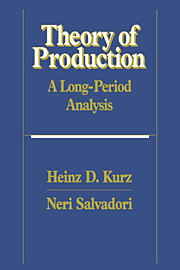Book contents
- Frontmatter
- Contents
- Preface
- A reader's guide
- 1 Free competition and long-period positions
- 2 A one-commodity model
- 3 Two-commodity models
- 4 Models with any number of commodities
- 5 Choice of technique
- 6 Alternative descriptions of a technique
- 7 Fixed capital
- 8 Joint production
- 9 Jointly utilized machines
- 10 Land
- 11 Persistent wage and profit rate differentials
- 12 On limits to the long-period method
- 13 Production as a circular flow and the concept of surplus
- 14 The neoclassical theory of distribution and the problem of capital
- 15 On some alternative theories of distribution
- Mathematical appendix
- References
- Name index
- Subject index
4 - Models with any number of commodities
Published online by Cambridge University Press: 06 January 2010
- Frontmatter
- Contents
- Preface
- A reader's guide
- 1 Free competition and long-period positions
- 2 A one-commodity model
- 3 Two-commodity models
- 4 Models with any number of commodities
- 5 Choice of technique
- 6 Alternative descriptions of a technique
- 7 Fixed capital
- 8 Joint production
- 9 Jointly utilized machines
- 10 Land
- 11 Persistent wage and profit rate differentials
- 12 On limits to the long-period method
- 13 Production as a circular flow and the concept of surplus
- 14 The neoclassical theory of distribution and the problem of capital
- 15 On some alternative theories of distribution
- Mathematical appendix
- References
- Name index
- Subject index
Summary
In this chapter models with any number of commodities will be analyzed. Moreover, it will be assumed that there is the same number of processes as there are commodities and that each process produces only one of these commodities. This implies that both joint production and the problem of the choice of technique are set aside. Chapter 3 has shown the importance of the distinction between basic and non-basic commodities. These concepts have to be defined in the present context (see Subsection 1.1). The following discussion is subject to two premises:
(i) there is at least one basic commodity, and
(ii) labor is required directly or indirectly in the production of all commodities, that is, at least one basic commodity is produced by employing a positive amount of labor.
The structure of the chapter is as follows. In Section 1 a model with only basic commodities will be investigated, while Section 2 will deal with models with both basic and non-basic commodities. Section 3 is dedicated to an analysis of the labor theory of value which figured prominently in early contributions to the theory of value and distribution. Section 4 will turn to a discussion of alternative standards of value or numeraires. Section 5 draws attention to earlier contributions to the theory of single production and Section 6 contains some exercises.
It should be mentioned that Chapter 6, which is concerned with providing alternative descriptions of a “technique,” can be considered a supplement to the present chapter. The discussion of the concept of the sub-system will be postponed until Chapter 6 in which a generalization will be provided.
- Type
- Chapter
- Information
- Theory of ProductionA Long-Period Analysis, pp. 94 - 126Publisher: Cambridge University PressPrint publication year: 1995



